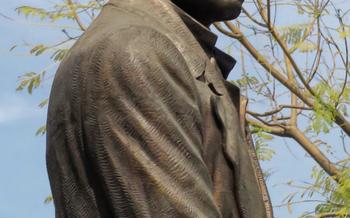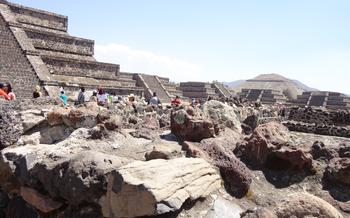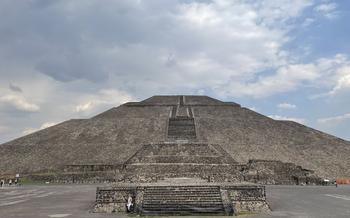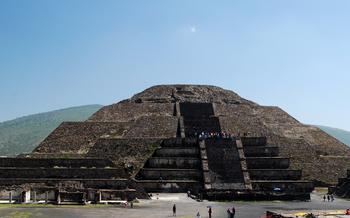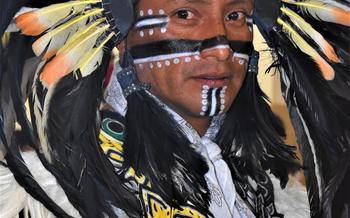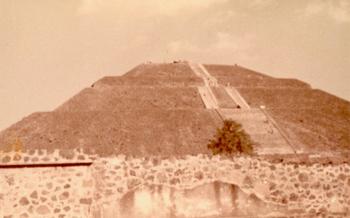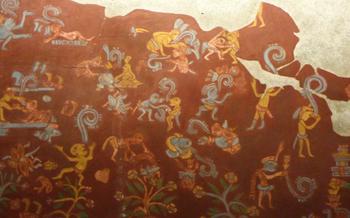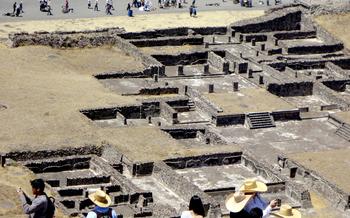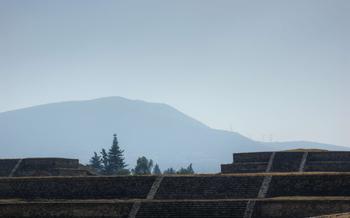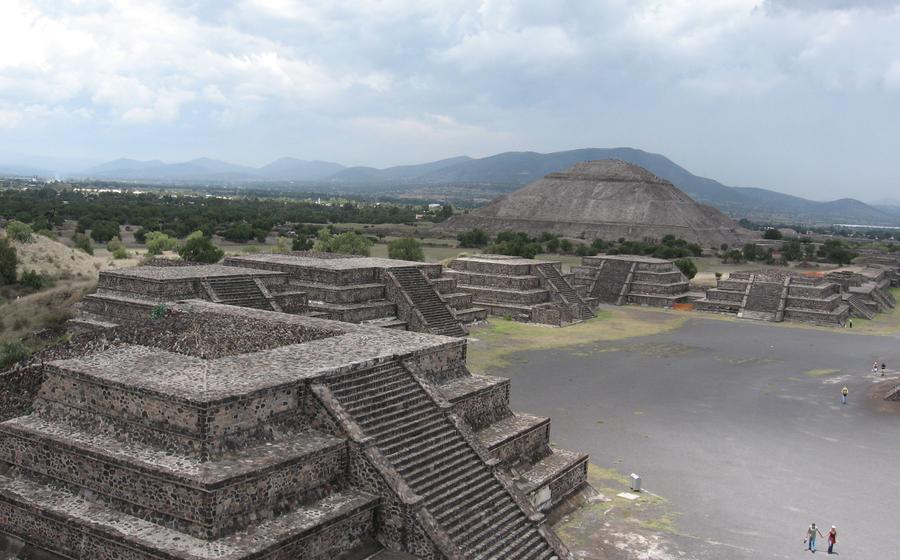
Teotihuacan en Bicicleta (Bike Tours)
- A journey through time
- Teotihuacan en Bicicleta
- Planning Your Visit
- Exploring the Avenue of the Dead
- Marveling at the Pyramids of the Sun and Moon
- Discovering the Temple of Quetzalcoatl
- Exploring the Palace of Quetzalpapálotl
- Visiting the Teotihuacan Museum
- Shopping for Souvenirs
- Enjoying the Local Cuisine
- Attending a Traditional Ceremony
- Visiting the Nearby Pulque Haciendas
- Exploring the Surrounding Area
- Insider Tip:
- Insider Tip: Embark on a Nighttime Adventure
A journey through time
Teotihuacan, a name that evokes images of ancient grandeur and awe-inspiring architecture, is an iconic city located just 50 kilometers northeast of Mexico City. Its origins can be traced back to the 1st century BC, making it one of the oldest and largest cities in the pre-Columbian Americas. The city flourished for over 600 years, reaching its peak in the 5th and 6th centuries AD, when it is estimated to have had a population of over 125,000 inhabitants.
Teotihuacan was the political, economic, and cultural center of a powerful empire that extended its influence over a vast region of Mesoamerica. The city was renowned for its monumental architecture, including the iconic Pyramids of the Sun and Moon, which were among the largest structures in the pre-Columbian world. The city's layout was carefully planned, with wide avenues, plazas, and temples arranged in a grid-like pattern.
Teotihuacan's significance extended beyond its physical grandeur. It was a city of great cultural and intellectual achievement, with a sophisticated system of writing, mathematics, and astronomy. The city's art and architecture reflected a unique blend of religious and symbolic elements, showcasing the creativity and ingenuity of its ancient inhabitants.
Although the exact reasons for Teotihuacan's decline and eventual abandonment remain a mystery, its legacy continues to captivate and inspire people worldwide. The city's ruins, which have been extensively excavated and restored, offer a glimpse into the splendor of an ancient civilization that played a pivotal role in shaping the history and culture of Mesoamerica.
Teotihuacan en Bicicleta
Teotihuacan en Bicicleta is a unique and unforgettable way to explore the ancient city of Teotihuacan. This guided bike tour takes you through the ruins, along the Avenue of the Dead, and to the top of the Pyramid of the Sun, offering a breathtaking panoramic view of the entire site.
The benefits of exploring Teotihuacan by bike are numerous. First, it allows you to cover more ground than you would on foot, so you can see more of the ruins in a shorter amount of time. Second, it's a great way to get up close and personal with the ancient structures, as you'll be able to ride right up to them and explore them at your own pace. Third, it's a fun and active way to experience the site, especially if you're traveling with family or friends.
There are a variety of different Teotihuacan en Bicicleta tour options available, so you can choose the one that best fits your interests and budget. Some tours are self-guided, while others are led by a professional guide who can provide you with historical context and insights into the ruins. Prices for tours start at around $30 per person.
Planning Your Visit
Teotihuacan is a popular tourist destination, so it's essential to plan your visit to make the most of your time. The best time to visit Teotihuacan is during the shoulder seasons (March-April and September-October) when the weather is pleasant, and there are fewer crowds.
To get to Teotihuacan from Mexico City, you can take a bus from the Terminal Central de Autobuses del Norte. The journey takes about an hour and costs around $You can also take a taxi or rent a car, but it will be more expensive.
Once you arrive in Teotihuacan, you can purchase tickets to the site at the main entrance. You can also rent bikes from one of the many bike rental shops in the area. If you're short on time, you can opt for a guided tour. There are various tours available, ranging from basic overviews to more in-depth explorations.
When planning your itinerary, consider the weather conditions. It can get very hot during the day, so it's essential to bring sunscreen, a hat, and plenty of water. You may also want to consider wearing comfortable shoes as you'll be doing a lot of walking.
Exploring the Avenue of the Dead
The Avenue of the Dead, also known as the Miccaotli, is the main thoroughfare of Teotihuacan. It runs for over two miles, connecting the Ciudadela to the Temple of the Moon. The avenue is lined with impressive structures, including temples, palaces, and residential compounds.
The Avenue of the Dead was once a bustling hub of activity. It was the city's main market, a place where people from all over the empire came to trade goods and ideas. The avenue was also a ceremonial center, where religious rituals were performed and public celebrations were held.
Exploring the Avenue of the Dead by bike is a great way to get a feel for the size and scale of Teotihuacan. It's also a great way to see the city's most important landmarks up close.
As you bike down the avenue, be sure to stop at the following landmarks:
- The Ciudadela: A large complex of temples and palaces that was once the city's administrative center.
- The Temple of Quetzalcoatl: A temple dedicated to the feathered serpent god, Quetzalcoatl. The temple is famous for its intricate carvings and sculptures.
- The Temple of the Sun: The largest pyramid in Teotihuacan and one of the largest in the pre-Columbian Americas.
- The Temple of the Moon: The second-largest pyramid in Teotihuacan and the only one that visitors are allowed to climb.
When exploring the Avenue of the Dead by bike, be sure to wear comfortable shoes and clothing. The avenue is long and dusty, so it's important to be prepared for the elements. It's also a good idea to bring water and snacks, as there are no food or drink vendors along the way.
Marveling at the Pyramids of the Sun and Moon
The Pyramids of the Sun and Moon are the most iconic landmarks of Teotihuacan. The Pyramid of the Sun is the largest pyramid in the city, and it is also the third-largest pyramid in the world. The Pyramid of the Moon is the second-largest pyramid in the city, and it is also the fifth-largest pyramid in the world. Both pyramids were built between the 1st and 2nd centuries AD, and they were used for religious ceremonies and rituals.
The Pyramid of the Sun is 216 feet (66 meters) tall, and it has a base of 761 feet (232 meters) by 721 feet (220 meters). The pyramid is made of adobe bricks, and it is covered with a layer of stucco. The pyramid has a steep staircase that leads to the top, and from the top, there are stunning views of the city and the surrounding countryside.
The Pyramid of the Moon is 150 feet (46 meters) tall, and it has a base of 500 feet (152 meters) by 450 feet (137 meters). The pyramid is made of the same materials as the Pyramid of the Sun, and it also has a steep staircase that leads to the top. From the top of the Pyramid of the Moon, there are views of the Pyramid of the Sun and the Avenue of the Dead.
Both pyramids are impressive feats of engineering, and they are a must-see for any visitor to Teotihuacan. However, it is important to note that the pyramids are very steep, and climbing them can be dangerous. It is important to wear comfortable shoes and to be prepared for the heat. It is also important to drink plenty of water and to take breaks as needed.
Discovering the Temple of Quetzalcoatl
Amidst the awe-inspiring structures of Teotihuacan, the Temple of Quetzalcoatl stands as a testament to the city's architectural prowess and religious devotion. Dedicated to the feathered serpent god, Quetzalcoatl, this temple is a masterpiece of ancient engineering and artistic expression.
Built in the early 7th century AD, the Temple of Quetzalcoatl is adorned with intricate carvings and sculptures that depict the deity's transformation from a serpent to a human form. The temple's facade is dominated by a massive mask of Quetzalcoatl, with its piercing eyes and serpentine fangs. Flanking the mask are two colossal serpents, their bodies entwined and their heads reared back in a menacing display.
The interior of the temple is equally impressive, with a series of chambers and corridors that lead to a central sanctuary. The walls are covered in vibrant murals depicting scenes from Quetzalcoatl's life and mythology. These murals offer a glimpse into the religious beliefs and cultural practices of the ancient Teotihuacans.
Exploring the Temple of Quetzalcoatl by bike allows visitors to appreciate its grandeur and intricate details up close. The surrounding plazas and courtyards provide ample space to park your bike and take a leisurely stroll, immersing yourself in the temple's sacred atmosphere.
Exploring the Palace of Quetzalpapálotl
The Palace of Quetzalpapálotl is one of the most impressive structures in Teotihuacan. It was built around the 6th century AD and is believed to have been the residence of the city's elite. The palace is named after the butterfly goddess Quetzalpapálotl, who was associated with fertility and creation.
The Palace of Quetzalpapálotl is a large complex that consists of several courtyards, rooms, and terraces. The most notable feature of the palace is its elaborate murals. These murals depict scenes from the life of the city's elite, as well as religious and mythological scenes. The murals are some of the best-preserved examples of Teotihuacan art and provide valuable insights into the city's culture and beliefs.
Tips for exploring the Palace of Quetzalpapálotl by bike:
- Take your time: The Palace of Quetzalpapálotl is a large complex, so it's important to take your time exploring it. There are many details to see, so don't rush through your visit.
- Bring a camera: The murals in the Palace of Quetzalpapálotl are some of the most iconic examples of Teotihuacan art. Be sure to bring a camera to capture these beautiful works of art.
- Be respectful: The Palace of Quetzalpapálotl is a sacred site, so be respectful of the space and the people who are visiting it.
Visiting the Teotihuacan Museum
The imposing Teotihuacan Museum, situated at the foot of the majestic Pyramid of the Moon, houses a treasure trove of artifacts and exhibits that shed light on the city's storied past. Explore the museum's fascinating collection to gain insights into the lives, customs, and beliefs of the ancient Teotihuacanos. Marvel at the intricately carved stone sculptures, pottery, and murals that depict their vibrant culture and artistry. Learn about the city's sophisticated urban planning, irrigation systems, and agricultural practices that sustained its thriving population. The museum also houses a replica of the famous "Smiling Head" sculpture, a masterpiece of Teotihuacan craftsmanship. Take advantage of the museum's bike racks to conveniently park your bike while you delve into the captivating history of this ancient metropolis.
Shopping for Souvenirs
When visiting Teotihuacan, you'll have the opportunity to shop for unique souvenirs to commemorate your trip. The best places to shop for souvenirs are the stalls and shops along the Avenue of the Dead and in the Teotihuacan Archaeological Zone. You'll find a wide variety of souvenirs to choose from, including pottery, textiles, jewelry, and replicas of ancient artifacts.
When shopping for souvenirs, be sure to bargain with the vendors. Bargaining is a common practice in Mexico, and you can often get a good deal if you're willing to haggle. Be polite and respectful, and start by offering a price that is about half of what the vendor is asking. Be prepared to walk away if the vendor doesn't come down in price.
Some of the most popular souvenirs from Teotihuacan include:
- Pottery: Teotihuacan is famous for its pottery, which is often decorated with intricate designs and colors. You can find everything from small bowls and vases to large pots and planters.
- Textiles: Teotihuacan is also known for its textiles, which are often made from cotton or wool. You can find a variety of textiles, including blankets, skirts, shirts, and dresses.
- Jewelry: Teotihuacan is a great place to find unique jewelry, such as necklaces, bracelets, and earrings. You can find jewelry made from a variety of materials, including silver, gold, and gemstones.
- Replicas of ancient artifacts: If you're looking for a unique souvenir, you can find replicas of ancient artifacts, such as pottery, figurines, and masks. These replicas are often made from the same materials as the originals and are a great way to learn more about the history of Teotihuacan.
Enjoying the Local Cuisine
Teotihuacan offers a diverse range of culinary delights that reflect the rich cultural heritage of the region. From traditional Mexican dishes to international fusion cuisine, there is something to satisfy every palate.
One of the best places to sample local cuisine is the Mercado de Artesanías y Comida. This vibrant market offers a variety of food stalls serving up everything from fresh produce and traditional Mexican dishes to international fare. Be sure to try some of the local specialties, such as barbacoa, a slow-cooked lamb dish, or pulque, a traditional Mexican alcoholic beverage made from fermented agave sap.
For a more upscale dining experience, head to one of the many restaurants in the city center. Here, you can enjoy gourmet Mexican cuisine prepared with fresh, local ingredients. Be sure to try some of the regional specialties, such as mole, a complex sauce made with chocolate and chili peppers, or mixiotes, a barbacoa dish cooked in a maguey leaf.
No matter where you choose to eat, be sure to sample some of the local fruits, such as prickly pears, guanabanas, and papayas. These delicious and nutritious fruits are a great way to end a meal or enjoy a refreshing snack.
Attending a Traditional Ceremony
Attending a traditional ceremony in Teotihuacan offers a profound insight into the spiritual and cultural heritage of the ancient city. These ceremonies are deeply rooted in the beliefs and traditions of the Nahua people, who have inhabited the region for centuries. The most significant ceremonies are held during the equinoxes and solstices, when the sun aligns perfectly with the Avenue of the Dead. During these ceremonies, participants gather at the pyramids to pay homage to the sun god, Huitzilopochtli, and to ask for blessings for the coming year.
There are various types of traditional ceremonies held in Teotihuacan, each with its unique significance and rituals. Some of the most popular ceremonies include the Ceremony of the Five Directions, the Ceremony of the New Fire, and the Ceremony of the Dead.
To attend a traditional ceremony in Teotihuacan, it is essential to be respectful of the local customs and traditions. Visitors are expected to dress appropriately, refrain from taking photos or videos during the ceremony, and maintain a quiet and reverent demeanor. By observing these guidelines, visitors can immerse themselves in the sacred atmosphere of these ancient rituals and gain a deeper understanding of the spiritual heritage of Teotihuacan.
Visiting the Nearby Pulque Haciendas
Pulque, a traditional Mexican alcoholic beverage made from fermented agave sap, holds a significant place in the history and culture of Teotihuacan. During the city's heyday, pulque was a ceremonial drink used in religious rituals and celebrations. Today, visitors to Teotihuacan can experience the ancient tradition of pulque making by visiting one of the nearby pulque haciendas.
These haciendas, which are essentially large farms dedicated to pulque production, offer guided tours that provide an insight into the process of making this unique beverage. Visitors can learn about the history of pulque, witness the harvesting of agave sap, and see how it is fermented into pulque. Of course, no visit to a pulque hacienda would be complete without sampling the finished product. Tours typically include a tasting of different types of pulque, allowing visitors to appreciate the subtle variations in flavor and texture.
For an authentic and immersive experience, plan to visit a pulque hacienda during the annual Pulque Festival, held in February or March. This vibrant festival celebrates the cultural significance of pulque and features traditional music, dance, and, of course, plenty of pulque to sample.
Exploring the Surrounding Area
Beyond the confines of the archaeological site, the region surrounding Teotihuacan is a treasure trove of natural and cultural attractions. For those seeking a deeper immersion, venturing into the neighboring landscapes offers a chance to discover hidden gems and gain a more comprehensive understanding of the region's rich history.
One captivating excursion is a visit to the Cerro Gordo Archaeological Zone, located just a few kilometers from Teotihuacan. Here, visitors can explore the remains of an ancient city that predates Teotihuacan, offering a glimpse into the region's earliest inhabitants. The site features a series of impressive pyramids, temples, and plazas, providing a fascinating contrast to the grandeur of Teotihuacan.
Another worthwhile destination is the Santa Maria Ozumbilla Archaeological Zone, situated approximately 10 kilometers from Teotihuacan. This site is renowned for its well-preserved murals, which depict scenes from daily life, religious ceremonies, and mythological tales. The vibrant colors and intricate details of these murals offer a unique perspective on the culture and beliefs of the ancient Teotihuacanos.
Nature enthusiasts will find solace in the Sierra de Patlachique National Park, located just south of Teotihuacan. This beautiful park encompasses a diverse range of ecosystems, including forests, grasslands, and wetlands. Visitors can embark on scenic hiking trails, spot an array of wildlife, and immerse themselves in the tranquility of the natural surroundings.
Insider Tip:
Unveiling the Secrets of the Tunnels of Teotihuacan
Beneath the surface of Teotihuacan lies a hidden network of tunnels that offer a unique and thrilling adventure for intrepid explorers. While access to these tunnels is restricted and requires special permission, those who manage to secure a permit will be rewarded with an unforgettable experience. The tunnels provide an intimate glimpse into the ancient city's intricate water management system and reveal hidden chambers and artifacts that have remained undisturbed for centuries. This exclusive journey through the heart of Teotihuacan is a once-in-a-lifetime opportunity to uncover the secrets that lie beneath the surface. So, if you're seeking an extraordinary and off-the-beaten-path experience, be sure to inquire about the possibility of exploring the Tunnels of Teotihuacan.
Insider Tip: Embark on a Nighttime Adventure
Unleash your adventurous spirit and explore the wonders of Teotihuacan under the cloak of darkness. Embark on a nighttime tour and witness the ancient city illuminated by the ethereal glow of the moon and stars. This unique experience offers a different perspective, allowing you to appreciate the grandeur of the pyramids and temples bathed in a mystical aura. Immerse yourself in the tranquility and serenity of the night, creating an unforgettable memory that will stay with you long after your visit.
